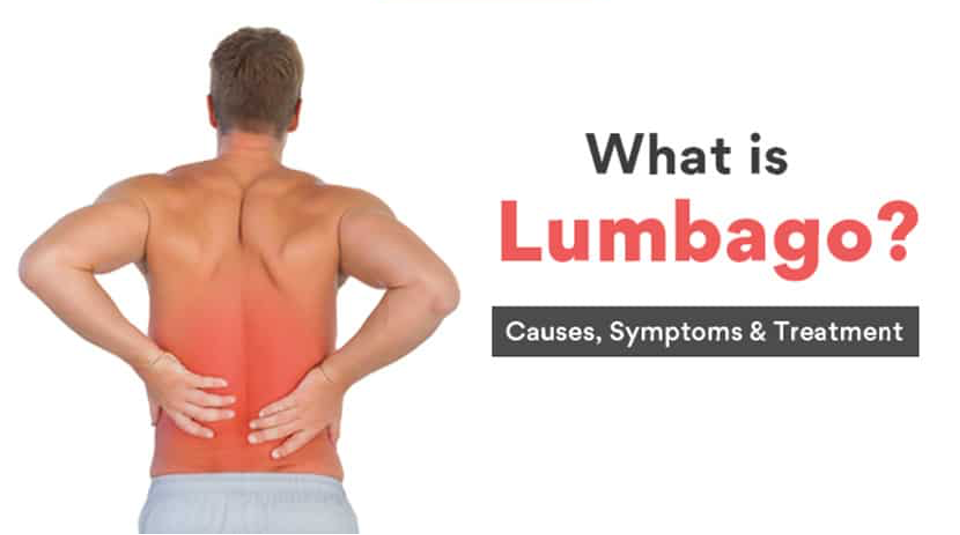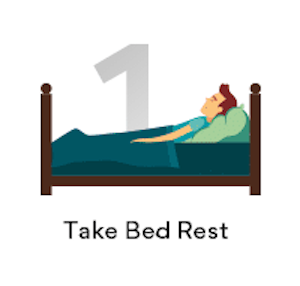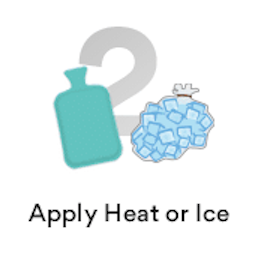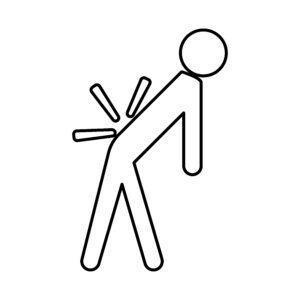Lumbago is a general term used to describe back pain in the lower back region. It can vary from mild to severe back pain. Lumbago is very common and affects 80% of the population. It is common for all ages and in young people who have demanding physical work.

Lumbago is an old fashioned term and is not used commonly today. It is also used to indicate mechanical low back pain and backpain without any cause identified. The term ‘lumbago’ means pain in the muscles and joints of the lower back.
What are the types of Lumbago?
There are 2 types:
Acute Lumbago:
- Occurs suddenly lasting less than 6 weeks
Chronic Lumbago:
- Lasting more than 6 weeks
What is the causes of lumbago?

There is no real cause for lumbago and it is used instead of ‘low back pain’. However, there appears to be some associations with lumbago:
- Overuse of your lower back
- Sudden lifting of a heavy load
- Excessive bending or repetitive movements of your lower back
- Arthritis of the spine, known as spondylosis
What are most common symptoms of Lumbago?
The back pain is usually located in the lumbar area. This is the area of your lower back. Along with the back pain, there is stiffness of the lower back, ache and spasm. The pain is around a small area of your back. You may find it difficult to move around, bend forwards or lean backwards. Sneeze or cough aggravates the pain.
There may be a change in your posture due to the severe pain and spasm. Occasionally, the low back pain can spread out to your buttock, groin or the back of your thigh. Lumbago can rarely extend into the foot with tingling and numbness. When this happens, it is called sciatica. Now all is not lost, you can still recover using the treatments below.
How do you treat lumbago pain?
1) Bed Rest - Reduce physical activity:

Stop physical activity for a few days. Bed rest for more NOT than 3 days to control Lumbago. A few days rest will help calm your low back pain and stiffness as more rest is bad for back pain.
This will help you manage the lumbago pain and move around as the pain is well under control.
2) Apply Heat or Ice to your Back:

This helps control your Lumbago pain. Some are comfortable with a hot water bottle as it helps muscles to relax. But others find a cold compress useful as it reduces the inflammation.
Choose what you feel that is comfortable for you. Both methods give the same result. Do not use them for more than 5 minutes at a time.
3) Over the counter Medications:

Most of us try an anti-inflammatory gel or ointment that can be applied over the painful area. This is a very safe practice and it also helps to massage the area gently to relieve the pain. It works directly all the skin and muscles. The side-effects are far less than oral medications.
The most commonly used over the counter pain medications are non-steroidal anti-inflammatory drugs (NSAIDs) like Paracetamol and Neurofen (Brufen).
4) Mild Stretches for Lumbago:

Mild stretches loosens your tense back muscles and strengthens other muscles in Lumbago. It is a good idea to take each step gently as any stretches that causes pain can cause damage to the muscles.
These stretches need to be simple with gentle forward bending, backward bending and mild twisting within the limit of your pain. Once you get used to it, regular stretching can ease your back pain effectively.
5) Improve your posture:

We all spend most of your time sitting down. This may be during eating, reading, watching TV or at work. Your posture may be more harmful than you realise and contributes to making your lumbago worse.
Look carefully at your posture, pay a little attention and make sure that your back are lined up nicely in a straight line while standing, sitting and during all the activities of daily living.
Is lumbago the same as Sciatica?

Lumbago is not the same as Sciatica
Lumbago pain is limited to the lower back and does not normally extend to the legs and cause ‘sciatica’. It is also known as ‘axial back pain’ as it involves only the spine not the legs.
Your posture can cause mechanical back pain with stress on the bones, ligaments and soft tissues of your back. The sciatic nerve is not trapped in the spinal canal.
In sciatica, the pain travels down the leg from your back. There is associated numbness, tingling of the legs and feet. There is usually a cause for pain down the legs like disc prolapse and lumbar stenosis.
How long does it take for lumbago to heal?
Most of the time, the cause for lumbago may not be identified. It may just be the case of a strained tissue in your back. The acute pain will resolve spontaneously over time as the irritated and sprained tissues of your back will heal eventually.
More than half the lumbago pain settles within 2 weeks and 80% in a period of 6 weeks. But 1 in 3 sufferers will have a relapse of the back pain or will develop chronic persistent pain in the future. This is called ‘chronic lumbago’. This is present in 1% of the population.
Lumbago and Back Pain Red Flags
We must be very careful not to over look this type of ‘mechanical back pain’. Occasionally, it has been known that we must be aware of ‘red flags’ that may suggest a more serious problem in addition to back pain. Urgent assessment and treatment is advised.
What are the ‘Red Flag’ signs:
Unexplained pain under 20 or over 55 years of age
Back pain not settling after injury
Back pain that is constant and getting worse
A cancer patient or cancer survivor
High of long time steroid treatment
Sudden loss of weight
Intravenous drug abuse suggesting decreased immunity
HIV positive with immunosuppression
When is the right time to see a Spine Surgeon?
Wait and see how the above treatment at home works. After a week, if you still feel that you are not able to get back to work, then please contact your GP or reach out to me on 07956 318383.
